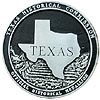| |
|
|
Sheep and Goat Industry in Texas |
|
 |
|
3 mi. NW of San Angelo on SH 87, San Angelo,
TX,
USA
Latitude & Longitude:
31° 33' 0.35129999988",
-100° 30' 34.5143599992"
|
| |
| |
|
Texas State
Historical Marker |
Spanish explorers introduced sheep to the Soutwest in the 1500s, and Spanish missions depended on the animals for food and clothing. The first Angora goats, known for the beauty and strength of their mohair, were brought to Texas in 1853 by Col. W. W. Haupt. Pioneer of modern sheep ranching in Texas from 1857 to 1867 was George Wilkins Kendall, who encouraged others with glowing reports of the industry's future while improving his own flocks. Kendall was one of the first to crossbreed the coarse--wooled Mexican churro sheep with the fine-wooled merino variety brought by European settlers. The land, climate, and vegetation of the Edwards Plateau area especially suited the raising of sheep and goats. After 1870, with new markets and abundant land, the industry boomed. Ranchers fought disease, predators, deadly plants, and drouths to build their flocks. Today Texas is the leading producer of sheep and goats in the nation, and San Angelo is the major market center for these animals and their wool. Research facilities such as the San Angelo Research and Extension Center, built in 1969 through the efforts of Gen. Earl Rudder, then president of the Texas A&M System, work for the industry's continued prosperity. (1974)
This page last updated: 7/15/2008 |
Sheep and Goat Industry Historical Marker Location Map, San Angelo, Texas
|
|
|
|


